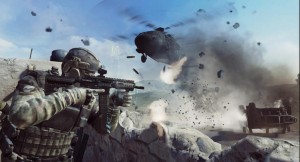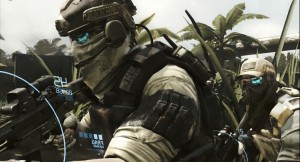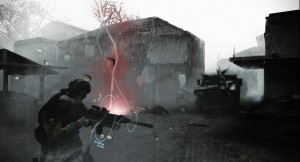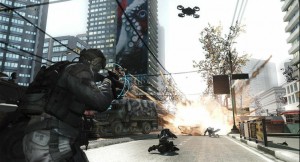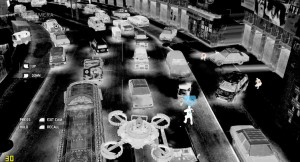Tom Clancy’s Ghost Recon: Future Soldier review (Xbox 360)
Review by John Cranston
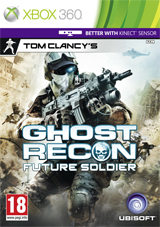 This week I learned “techno-thriller”, while sounding like the title of a Lady Gaga song, is in fact a genre of fiction largely populated by the works of Tom Clancy. With the release of Ghost Recon: Future Soldier, you’re once more invited into his world of soldiers, spies and souped-up guns and gizmo’s.
This week I learned “techno-thriller”, while sounding like the title of a Lady Gaga song, is in fact a genre of fiction largely populated by the works of Tom Clancy. With the release of Ghost Recon: Future Soldier, you’re once more invited into his world of soldiers, spies and souped-up guns and gizmo’s.
This is the fourth in the Ghost Recon series of stealth-shooter hybrids, available on Xbox 360 and PS3 (later on PC), in which you take charge of a team of high-tech soldiers on an explosive romp around the conflict zones of the world.
If there’s one thing readers of this website will appreciate, it’s that gadgets are cool. Sure, most of us will never get to hold anything capable of killing a man, perhaps with the exception of the Samsung Galaxy Note, but thanks to video games we can do just that, with both actual and fictional toys the likes of which would have Steve Jobs filing patent lawsuits from his grave.
The members of Ghost Recon squads are modern-day battle-mages, highly trained soldiers equally adept at using firearms as they are a Bluetooth keyboard. They probably cost the Pentagon a fortune in expenses, so when a dirty bomb wipes out a whole squad of them at the beginning of the game, no stone will remain unturned as Pepper, 30K, Kojak and Hunter (probably not their real names) don their stealth suits and travel around the world on the trail of the madmen responsible.
And travel they do – this game seems to have more locations than a Call of Duty. That’s partly a bad thing – the story suffers the strains of such fast progression (unless it’s purposefully bad as a sort of trolling move toward Activision) – but it certainly lets the artistic teams off the leash and as a result there are some really beautiful places that you will be killing people. Zambia, Pakistan, Bolivia, The Barents Sea and Moscow to name just a few.
Being part of a squad is the primary mechanic in Future Soldier and the campaign is capable of being played by up to 4 players. Friendless people need not fear though; the AI of your allies is extremely competent. Forget about micromanagement, simply mark up to four enemies for execution and your CPU allies instantly optimise their placement on the battlefield in order to take a synchronous shot when you give your order (or accidentally fumble your way into a stealth kill by walking too close to an enemy soldier).
Of course these enemies don’t just arrange themselves in a neat line, for every guard walking a fixed patrol there are an equal number of snipers and machine gunners sneakily entrenched out of plain sight. Alert them and they raise the alarm, leading to even more foes. Utilising the toys at your disposal will allow you to scout the battlefield and attack every foe silently from the shadows – and most of the time this is possible, though there were a few occasions I found that you could not progress without participating in a scripted fire fight.
Night vision and thermal goggles are pretty standard fare in shooters now, but the x-ray goggles were a superb new experience for me – showing the enemies and the guns they hold in a manner reminiscent of Total Recall. Sensor grenades highlight enemies on your HUD and remote controlled quadrotors equipped with thermal cameras allow you to get an aerial view of enemy positions, or alternatively can be switched to a land-based mode with a stun gun ability.
The coolest gadget though, is sadly only utilised on one mission, though I think this may have been for balance purposes on account of it being so bloody awesome. You are accompanied with what can only be described as the evolution of Boston Dynamic’s BigDog – a four legged walking piece of camouflaged cover mounted with a mortar and remote controlled missiles. Its loud, it’s destructive, but for the one mission it’s available you’ll get a hell of a kick out of being unstealthy.
Gadgets aside, the rest of your time will be spent customising and wielding the many weapons available in Future Soldier. As you are given mission briefings, your commanding officers will issue you with a recommended weapon and a series of attachments suitable for that engagement. You’re free to change these in the Gunsmith menu (more on that later) but most of the extra guns and attachments are locked until you meet specific objectives. As you’ll be likely be playing several times in co-op mode, these extra little goals can only help maintain interest.
I’m not the most competent at stealth games, but I got a lot of satisfaction from the multiple attempts I took at completing Future Soldier. Checkpointing is fair and will usually allow you to restart an encounter without too much repetition. And for those occasions where you desperately fail at the stealth parts, shooting your way to victory is a possible, albeit lengthier, solution. Activating your stealth mode, sneaking around and eliminating every enemy is definitely the most fun way of doing things.
Controlling your ghost is extremely simple; being able to quickly switch the shoulder that the third person camera sits on comes in very handy, especially when proning – bodies don’t clip through walls like in Battlefield so you need to be able to position yourself carefully. A few on-rails sections are also included (the obligatory minigun on a chopper is here, of course) where the ghost squad huddle together to escort high value targets out of an area. They don’t last long, but are a nice touch, reminiscent of Army of Two’s back-to-back moments.
The campaign itself lasts around 12 hours on the most difficult setting, I enjoyed it immensely but sadly due to playing the game pre-launch I cannot give any opinion how it fares in co-operative mode. The campaign is certainly not without flaws, in a disparate way from the actual gameplay, the interim scenes lack any real polish or cinematic direction. Also, in those scenes, character models appear to have skin made from plasticine and are unable to move their lips in time with the dialogue.
In addition to the campaign there’s a solo/co-op experience called “Guerrilla Mode”, which is basically like every other survival mode out there. A squad of four ghosts team up to defend an outpost from increasingly difficult enemy waves (up to 50 of them) and surviving waves grants perks such as automated turrets, claymores, airstrikes and the like. The real challenge will be scoring high – getting headshots, multiple kills in a small time window, synchronised strikes and so on grant you more points, and of course we all love beating our friends on leaderboards, don’t we?
Sadly there are only four available levels for Guerrilla (technically five, but you need to unlock one via the Ubisoft Uplay system) so I’m not sure how much longevity there will be to this, but compared to the multiplayer mode it is the closest you’re going to get to a proper “Ghost” experience – stealth suits, thermal goggles and all the other cool gizmos make an appearance without any unlocking necessary.
Multiplayer offers you four differing game modes across ten maps and can have up to 16 players split into two teams of eight – each then split into two squads of four for tactical spawning and objective marking purposes. You’ll be able to play as one of three classes – Rifleman, Scout and Engineer – each of whom specialise in one general discipline, thus making you approximately one third as dangerous as a proper Ghost.
Starting at the bottom rung of the multiplayer ladder you have the most basic of field equipment, but as you level up you get the choice of new gadgets and guns and also receive “unlock credits” which can be used to purchase scopes, magazines, barrels and other such groovy attachments in Gunsmith. It’s a shame that the work you do in the campaign doesn’t carry over to your multiplayer character, but it shouldn’t take too long to find your feet once you’ve figured out the basics.
In Conflict you have a fifteen minute window in which to make your team complete as many objectives as possible, these are decided on the fly and are involve killing/defending a chosen team member, holding/securing a point on the map, etc. In Decoy, attackers are allocated three objectives, one of which (at random) will trigger a final objective which needs to be done to score and the game is played over the best of three rounds.
The goal in Saboteur is to pick up a bomb from the centre of the map and arm it in your opponents’ base. Setting off the bomb secures a victory, but in the event of a tie whichever team displayed the most teamwork (assists, following orders, marking targets etc) wins. Finally, in what will probably prove to be the most popular mode – Siege – you play without respawns, one team attacking, one team defending, scored as the best of three rounds.
Choosing the right class and co-operating with your team are the keys to success in multiplayer. Though all the modes award points for kills, it’s the achieving of objectives that turns the game around. That and the careful use of intel hacking – using a stun gun to taze an enemy and then hacking into his communications gear to reveal the positions of his squad mates. Again, due to the constraints of playing pre-launch, I didn’t spend nearly enough time with Decoy and Saboteur, but Conflict and Siege proved to be equal measures of fun and infuriating.
I think the most interesting and cool of all Future Soldier’s feature is Gunsmith. In this mode, which is used in both campaign and multiplayer, you select a weapon, watch it get disassembled and then have the fun of playing around with a seemingly endless array of internal and external fitting configurations for optics, triggers, magazines, barrels, muzzles, grips, camo and more. Hold down the trigger and the gun magically reassembles itself for your viewing pleasure or testing on the firing range.
So if you prefer your assault rifles with silenced scopes and bipods, or your shotguns with full auto triggers and armour-piercing shells you can be sure that Gunsmith will let you tweak them to perfection, providing of course you have unlocked them. You can even use Kinect to play with Gunsmith, though waving your arms around to swivel and select pieces is a jarring and unnecessary experience.
Future Soldier is a game you play sitting down with controller in hand and after trying out the Kinect firing range, I don’t think that’s going to change any time soon. The inclusion of voice commands is pretty much the only good point of the “Better With Kinect” integration, but even then that is only in certain parts of Gunsmith, so mostly useless. In fact, the amount of “Feeling tired or sore? Why not take a break?” messages I got while playing ended up with it being disabled from the game menu.
It’s one of only a few small negative issues I had with this game, so please don’t let it put you off as you can ignore it completely and it would be a shame to miss out on a great tactical shooter for the sake of a marketing gimmick. I always remember the Ghost Recon games as being notoriously tough, but it appears the homogenisation that comes with competing in the modern shooter market has transformed this game into something a lot more accessible and enjoyable.
 Tom Clancy’s Ghost Recon: Future Soldier scores 8 out of 10.
Tom Clancy’s Ghost Recon: Future Soldier scores 8 out of 10.
